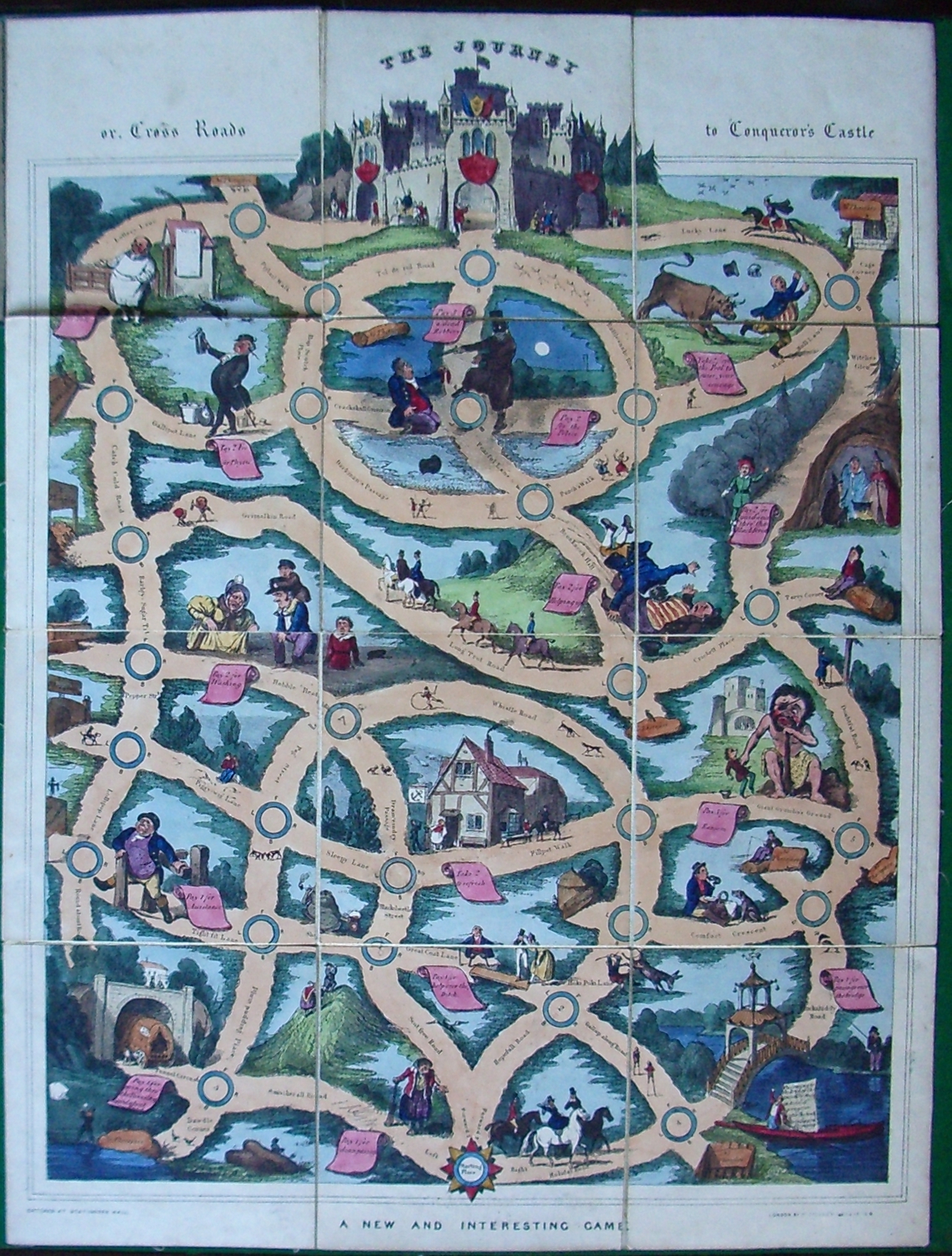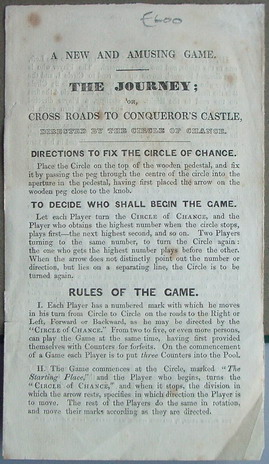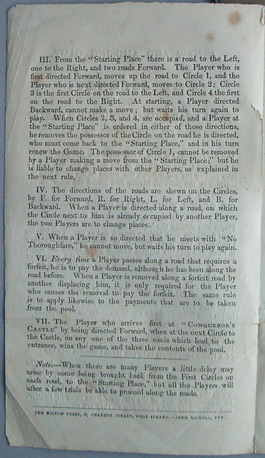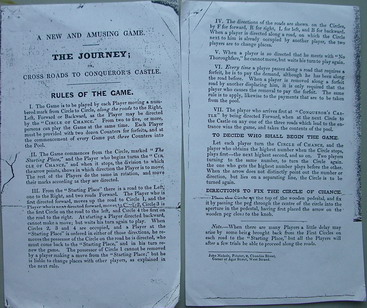Giochi dell'Oca e di percorso
(by Luigi Ciompi & Adrian Seville)
(by Luigi Ciompi & Adrian Seville)

|
Giochi dell'Oca e di percorso
(by Luigi Ciompi & Adrian Seville) |

|
 |

Torna alla ricerca giochi (back to game search) |
 |
| Journey (The) or Cross Roads to Conqueror's Castle | ||
 |
Versione stampabile
 |
Invia una segnalazione

|
   |
primo autore: | Anonimo |
| secondo autore: | Spooner William | |
| anno: | 1835/6 | |
| luogo: |
Inghilterra-Londra |
|
| periodo: | XIX secolo (2°/4) | |
| percorso: | Percorso di | |
| materiale: | carta incollata su tela (engraving on paper with linen backing) | |
| dimensioni: | 000X000 | |
| stampa: | Litografia colorata a mano (hand-coloured engraving) | |
| luogo acquisto: | ||
| data acquisto: | ||
| dimensioni confezione: | ||
| numero caselle: | 0 | |
| categoria: | Geografia | |
| tipo di gioco: | Gioco di percorso | |
| editore: | Published by W. Spooner, 259 Regent Street, Oxford Street. | |
| stampatore: | Published by W. Spooner, 259 Regent Street, Oxford Street. | |
| proprietario: | Collezione E. C. | |
| autore delle foto: | E. C. | |
| numero di catalogo: | 1349 | |
| descrizione: |
Gioco con percorsi multipli con cerchietti non numerati. REGOLE: non riportate sul tavoliere. CASELLE: mute. REFERENZA 1 "The Journey or Cross Roads to Conqueror's Castle". (V&A Museum) This game is in the form of a landscape with rivers, roads and houses. Players must start from the centre of the bottom margin and using the teetotum move along the roads in the direction determined by the spin. The teetotum is marked L F R B, for left, forward, right and back. A spin occurs at each cross roads and the first spin must be left, right or forward. Various rewards and forfeits are given along the roads and must be complied with. The roads have humorous names and are populated with little groups. The winner is the player who reaches the Conqueror's Castle first. Physical description Design: lithograph, coloured by hand; 12 sections mounted on linen; showing a castle with roads leading to it. N°of squares: ? Squares illustrated: all Square numbering: none Squares titled: none Subject of starting square: cross roads at centre bottom Subject of ending square: castle at centre top Place of Origin: London Date: 1837-1846 Artist/maker: Spooner, William Materials and Techniques: Hand coloured paper on linen Dimensions: Height: 22.25 in; width: 16.75 in Object history note: it is played in a similar way to The Cottage of Content, E. 1785-1954. William Spooner was at the address between 1837 and 1846. The original imprint would be prior to 1836 and this is a later impression. Sheet marked Entered at Stationers' Hall Historical context note Rewards: receipt of counters and forward movement; given on the playing sheet as the marker is moved Forfeits: payment of counters and backward movement; given on the playing sheet as the marker is moved. N°of Players: any Equipment required: teetotum marked L F R B (left, forward, right back); marker for each player; counters to a decided value with a given number for a central kitty or pool Rules: The game is in the form of a landscape with rivers, roads and houses. the players must start from the centre of the bottom margin and using the teetotum move along roads in the direction determined by the spin. A spin occurs at each cross roads and the first spin must be left, right or forward. Various rewards and forfeits are given along the roads and must be complied with. The winner is the player who reaches the Conqueror's Castle first. Like the Cottage of Content, the roads have humorous names and little groups of people. For Example: In Great Coat Lane, a beggar stands by a ditch and the penalty being `Pay 1 for help over the Ditch'. In Hobble Heath a family is bogged down and must `Pay 2 for Washing'. In Tight Fit Lane, a fat man is attempting to get through a turnstile, and is asked to `Pay 1 for Assistance'. Before attempting to pass along Mad Bull Lane, the player is told to `Take 2 from the pool to raise Courage'. Passing the Inn at Fillpot Lane, the player has to `Take 2 to Refresh'. The playing sheet folds into cloth covered boards bearing a pictorial label which also shows characters and buildings from the sheet itself. Rules placement: on the game as it is played Descriptive line: Hand coloured game, The Journey, published in England by William Spooner between 1837 and 1846. REFERENZA 2 WHITEHOUSE, Francis Reginald Beaman, (pag. 64): THE JOURNEY, or Cross Roads to Conqueror’s Castle. London. W. Spooner, 259 Regent Street, Oxford Street. A lithograph size 16 ¾ in X 22 in, hand-coloured, mounted in 12 sections on linen, folded into hinged boards, cloth-covered, with picture label on front. The game comprises a number of roads and paths leading from the starting place at the foot of the sheet to the castle at the top. Humorous figures occupy the spaces between the roads, the latter bearing such names as “Catch-cold Road", “Lollipop Lane", "Crackskull Common". Not dated, but prior to 1836. REFERENZA 3 "William Spooner publia aussi un jeu très semblable, qui portait comme titre "Le voyage ou Croisée des chemins pour le chateau du conquérant". Utilisant des légendes humoristiques et le meme format que "La maison de la satisfacion", le jeu est moins moral mais propose des difficultés que l'on doit surmonter. Par exemple, avant de passer le long du sentier du taureau fou, on dit au joueur: "prenez 2 à la cagnotte pour augmenter votre courage". Le voyage est une lithographie peinte à la main, publiée pa William Spooner entre 1837 et 1846. L'impression originale était antérieure à 1836." (GOODFELLOW Caroline) REFERENZA 4 "William Spooner was also the publisher of a very similar game, which bore the title "The Journey or Cross Roads to the Conqueror's Castle". Using humorous road titles and the same format of play as "The Cottage of Content", the game is less moral but poses difficulties that must be overcome. For example before attempting to pass along Mad Bull Lane, the player is told to "take 2 from the Pool to raise your courage". The Journey is a hand-coloured lithograph which was published by William Spooner between 1837 and 1846. The original imprint was prior to 1836." (GOODFELLOW Caroline) Exhibitions: - "Instruction and Delight: Children's Games from the Ellen and Arthur Liman Collection" (Yale Center for British Art, 17 January-23 May, 2019). |
|
| bibliografia: |
1) WHITEHAUSE, F.R.B.: "Table Games of Georgian and Victorian Days", London, Peter Garnett, 1951. 2) GOODFELLOW, Caroline: "A Collector's Guide to Games and Puzzles". Secaucus, New Jersey, Chartwell Books-London, Quintet Publishing Limited 1991. 3) GOODFELLOW, Caroline: "The Development of the English Board Game, 1770-1850", in Board Games Studies 1, 1998. 4) GOODFELLOW, Caroline: "Jeux de société. Le guide du collectionneur des jeux de société depuis le XVIIIe siècle jusqu’à nos jours", (Edizione francese) Carrousel MS, 2001. 5) SEVILLE, Adrian: "The Game of Goose: and its influence on cartographical race games" Journal of the International Map Collectors' Society, Winter 2008 N°115 2008. 6) SEVILLE, Adrian: "The geographical Jeux de l'Oie of Europe." In "Belgeo" 2008 3-4 2008. 7) GOODFELLOW, Caroline: "How We Played: Games From Childhood Past", History Press, 2012. 8) QUINN, Brian - CARTWRIGHT, William: "Geographic Board Games". Geospatial Science Research 3. School of Mathematical and Geospatial Science, RMIT University, Australia. December 2014. 9) SEVILLE, Adrian: "The Royal Game of the Goose four hundred years of printed Board Games". Catalogue of an Exhibition at the Grolier Club, February 23 - May 14, 2016. 10) LIMAN, Ellen: "Georgian and Victorian Board Games: The Liman Collection", Pointed Leaf Press, 2017. 11) NORCIA, Megan A.: "Gaming Empire in Children's British Board Games, 1836-1860". Studies in Childhood, 1700 to the Present. Routledge, 2019. 12) SEVILLE, Adrian: "L'arte dei giochi da tavolo. Oltre un secolo di storia e divertimento dalla fine del Settecento all'inizio del Novecento." Edizioni White Star, 2019. 13) PARLAK, Omer Fatih: "Seafearing through the Perspective of Historic Board Games", in DGSM, Köllen Druck+Verlag, Bonn 2020. |
|
| "The Development of the English Board Game, 1770-1850" (Caroline G. Goodfellow) | ||
| Games of Amusement. "Table Games of Georgian and Victorian Days". (Francis Reginald Beaman, Whitehause) | ||
Vai alla ricerca giochi Vai all'elenco autori